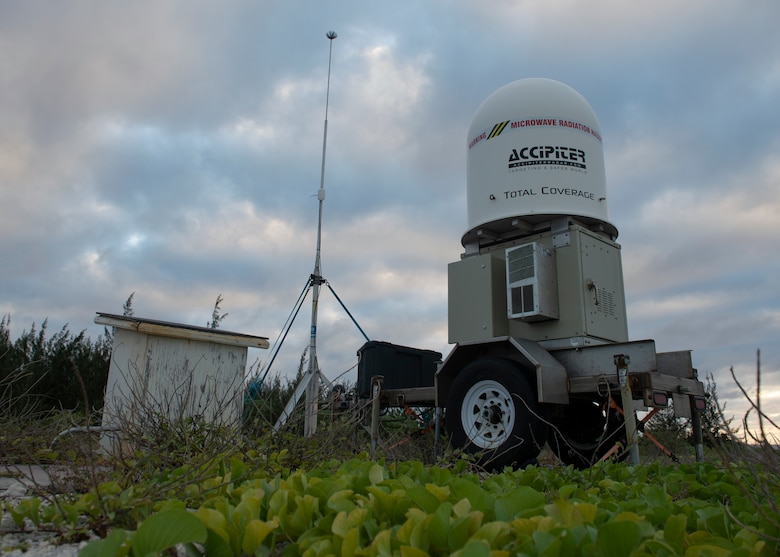Heavily bombarded during a bloody two-week battle in World War II and the subsequent 44-month occupation by the Japanese before being handed over to U.S. forces on Sept. 4, 1945, Wake Atoll has attested to the resiliency of U.S. military members and civilians.
Since those historic days, the island has been named a national historic landmark and serves as a trans-Pacific refueling stop for military aircraft.
Now under the Eleventh Air Force's Pacific Air Force Support Center, the island is fighting a new battle - preventing bird aircraft strike hazards, commonly known as BASH.
The island contains a large number of seabirds as part of the Wake Atoll National Wildlife Refuge and lies within the boundaries of the Pacific Remote Islands Marine National Monument, both of which raise special considerations in regards to natural resource management.
By hosting a wildlife refuge, the island has the added challenge of preventing bird strikes to minimize the environmental impacts while also taking readiness impacts with military aircraft in the area into careful consideration.
"The BASH program is so important on Wake because we do have a National Wildlife Refuge overlay, and we also have a lot of migratory seabirds," said Travis Pearson, Wake Island Atoll BASH specialist. "This creates an interesting balancing act. First and foremost, we have to keep the birds out of the way of the aircraft for flight safety, but secondly, so they can support healthy populations."
The BASH program also has to tackle how many birds are attracted to the island.
"The problem with Wake is the sheer number of birds," said Dillon Brown, 611th Civil Engineer Squadron natural resource program manager. "Most airfields have tens or hundreds of birds. Wake Island Atoll has hundreds of thousands of birds."
These numbers mean the island has a higher risk of bird strikes than other airfields and averages about five strikes a year.
"This (number) is about 30 to 40 times the national average when you account for the number of flight operations," Brown said. "However, given that the number of birds surrounding the runway is hundreds or thousands of times higher than other runways, this is actually a very low number. This attests to the effectiveness of our BASH program."
The multi-tiered BASH program on the island involves a large range of projects and efforts to deter birds from the flight line area while maintaining a healthy wildlife population.
The atoll is made up of Wilkes, Wake and Peale islands. Wake is the largest and contains most of the infrastructure of the islands as well as the flightline.
Currently, the majority of the birds inhabit Wilkes Island, which lies at the end of the airfield and is covered by the runway's approach.
Brown said this poses a major risk to incoming flights which have to fly over hundreds of thousands of birds to land.
To combat this risk, the BASH program is conducting a project to encourage birds to move from Wilkes Island to Peale Island, out of the flight path.
"The idea is that through active habitat management and bird attractants, we will gradually make Peale more attractive to the birds and Wilkes less attractive," Brown said. "Our planning and habitat management is targeted at moving these birds of greatest risk away from the runways."
The project involves changing the habitat in ways that will attract breeding birds to Peale Island by making it a better environment for nesting.
Brown notes that the variety of birds and their nesting habits is proving to be a challenge.
"There are numerous types of birds breeding on Wake Atoll," Brown said. "Unfortunately, they do not all have the same nesting requirements. Some breed on bare ground, some in tall grass, some under bushes, in bushes or on the tops of trees. Therefore, habitat management is very difficult because, as you make an area more attractive to some birds, you make it less attractive to others and vice versa."
In addition to habitat management, the project employs decoys and recordings of an active seabird colony through loudspeakers to attract birds to move across the lagoon.
Another new technological approach the island is taking to its BASH program is using radar to detect the number and location of birds in the flight path.
The radar, installed in March, can sense birds size, speed and direction.
"A benefit from the radar is it can look a good six or seven miles off of the end of the runway which gives us a way to warn aircraft about birds that we would never be able to see," Pearson said.
The island records this data from the radar to enable the airfield to see trends that may affect flight line operations in the long term.
Overall, through a culmination of the vital, multi-tiered BASH program the island employs, Wake Atoll demonstrates its commitment to a posture of mission success and readiness needed to support the U.S. military presence in the Pacific.

An avian radar system sits at the end of the runway at Wake Island, Wake Atoll, Jan. 31, 2020. The radar system was installed in March 2019 and is used by bird aircraft strike hazard specialists to collect data to track bird trends in the area. The radar also serves as a way to warn airfield operations, so they can communicate risks to incoming aircraft. This is part of the atoll's vital, multi-tiered bird aircraft strike hazard program which supports mission readiness and success. (U.S. Air Force photo by Airman 1st Class Emily Farnsworth)






